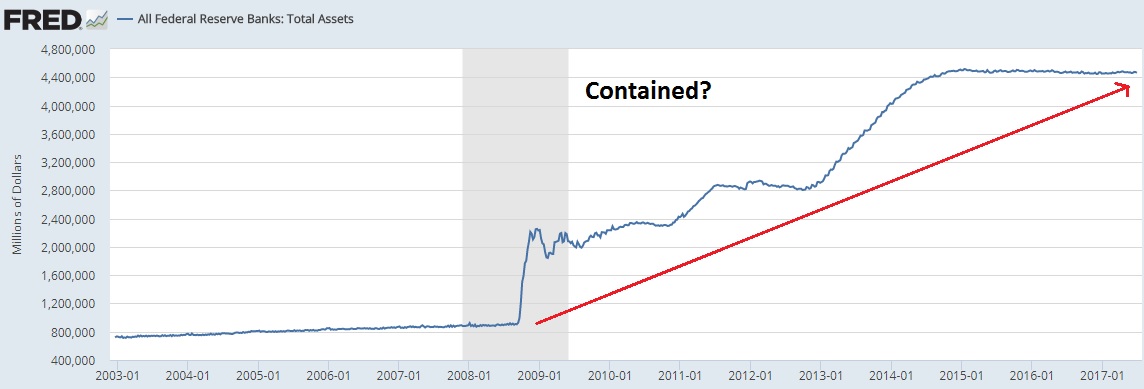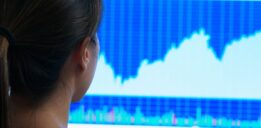Yellen’s “Not In Our Lifetimes” Quote May Portend a Market Top and Subsequent Stock Market Crash
She finally did it. Federal Reserve Chair Janet Yellen uttered the types of words that rational investors should find worrying. Her recent “Not in our lifetimes” quote exemplifies the stunning ignorance that the Fed has about the scope of America’s economic challenges.
In an exchange with British Academy President Lord Nicholas Stern, Yellen said: “Will I say there will never, ever be another financial crisis? No, probably that would be going too far. But I do think we’re much safer and I hope that it will not [happen] in our lifetimes…” (Source: “Yellen: I ‘don’t believe’ we’ll see another financial crisis in our lifetime,” Fox Business, June 27, 2017).
The cognitive dissonance in Yellen’s statement is breathtaking. Apparently, she thinks everything is just fine, and that the potential for another stock market crash is low. When a central bank head believes that risks are contained, it’s time to run for the exits. We’ve seen this movie before, and a historic stock market crash ensued.
For one, none of the problems built up during the past two recessions have actually been solved. Effects of the U.S. housing bubble, in particular, still linger. Emergency low interest rates were maintained for seven years before the Federal Reserve started its first rate-tightening cycle in December 2015. Then the Fed waited another full year before tightening the interest rate by another 25 basis points. The fed funds rate (FFR) was still below one percent, however.
Also Read:
5 Signs of a U.S. Economic Collapse in 2017
Stock Market Crash 2017? This Could Trigger a Stock Market Collapse
Ultra-low rates have allowed private and public borrowing to explode to new heights. Neither group can withstand higher rates; economic activity would crash. Economic growth has barely maintained stall speed, even with this excess liquidity. It’s delusional to think that anything has been solved. The problem has just been papered over.
Without central bank (CB) stimulus programs (QE1, QE2, Operation Twist, mortgage-backed security buybacks, etc.), a stock market crash would have already occurred. It’s plain as day that CB liquidity is driving the completely insane stock market multiples that we see today (relative to earnings). Meaningful earnings growth hasn’t happened in five years, and the International Monetary Fund (IMF) doesn’t expect America’s gross domestic product (GDP) to grow more than 2.1% until 2022. Yet the stock market keeps rising?
The traditional driver for individual stock gains—earnings growth—is dead. It has been replaced by CB intervention, which is crippling growth and making most everyone into debt slaves in order to make ends meet. And Janet Yellen doesn’t think we’ll see another financial crisis in out lifetime?
Perhaps Yellen believes there won’t be a crisis because the stock market sings to the tune of Fed liquidity. It seems to me that she’s mistaking the stock market for the real economy. That’s very disturbing. We will truly see how anti-prophetic her words are when the Fed tries to normalize its balance sheet.
Yellen Takes a Page Out of Ben Bernanke’s Playbook
Yellen could very well have had her Ben Bernanke moment.
On March 28, 2007, former Fed chair Bernanke had these amazingly anti-prescient words for investors: “…the impact on the broader economy and financial markets of the problems in the subprime market seems likely to be contained.” (Source: “30 Bernanke Quotes That Are So Absurd You Won’t Know Whether To Laugh Or Cry,” Business Insider, March 28, 2007.).
Of course, all was not contained. The subprime market was spiraling out of control, and the derivatives they were packaged in would soon go nuclear. The Dow Jones Industrial Average (DJIA) edged higher over the next several months before tanking by more than 50% by February 2009. Two staple Wall St. investment banks, Bear Stearns and Lehman Brothers, both collapsed. Housing lender Federal National Mortgage Association (known as “Fannie Mae”) became technically insolvent, and so did re-insurance giant American International Group Inc (NYSE:AIG).
Without emergency measures being taken, other financial institutions would have also collapsed. Credit markets ceased to function. The U.S. subprime bubble became the biggest financial crisis in at least three generations.
Contained? Hardly.
And here we are today, with Yellen spouting the same CB hubris that has been wrong so many times before. Had the economy truly been fixed, perhaps she’d have a point. But we have witnessed the complete opposite since 2009. Every metric related to elevated debt burdens and credit creation has increased substantially.
The U.S. national debt has risen from about $8.0 trillion to approximately $20.0 trillion in less than a decade. The Fed’s own balance sheet has risen from about $800.0 billion during the housing bubble to around $4.5 trillion today. Not only is the next economic crisis inevitable, the failure to curb risk appetite promises that the next crisis will be larger than ever.
But I don’t necessarily blame Yellen for her absurd musings. After all, I realize it’s hard to come to an accurate conclusion while perched atop an ivory tower. The Fed’s biggest problem is that it believes it is omnipotent. Unfortunately, average Americans will bear the brunt of this delusional line of thinking.







